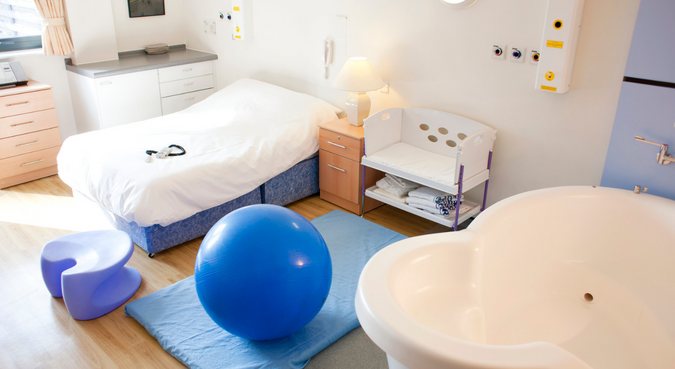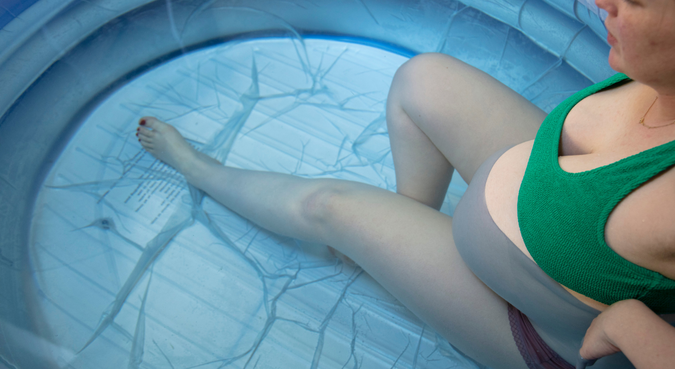This article is part of an editorial series, “Stork Stories,” brought to you by Fort Worth Moms. Join our subscriber list so you don’t miss a moment of “Stork Stories” and all Fort Worth Moms has to offer throughout the year.
Disclaimer :: The author is in no way a medical professional; this is solely her experience with the water birth. Please consult your doctor if you have any questions or concerns regarding your own health and pregnancy.
I’ve given birth to five babies: two hospital births and three at-home births with a midwife. Over the years, I’ve met with lots of questions, curiosity, and skepticism about my choice to go with natural childbirth. But nothing raises eyebrows quite like the mention of water birth.
Say what? You had a baby IN WATER?!
If you have questions about the benefits and risks of water birth, or you’re simply curious to read about someone else’s experience, you’ve come to the right place.
So What Is Water Birth, Exactly?
Hydrotherapy is the use of water during labor. Water birth refers to giving birth in warm water, typically a birthing tub or pool.
Women have been laboring and giving birth in water for centuries, but water birth was first officially reported in a medical journal in 1805.
The practice has gained popularity in the United States since the 1980s, but it’s surprisingly commonplace in the United Kingdom. In fact, 10 percent of women in the UK give birth in pools; nearly 20 percent use hydrotherapy during labor for pain relief.
My personal experience with hydrotherapy and water birth involved renting a birthing tub and laboring/birthing at home with a midwife.

Water birth is a fabulous option for many women, but it’s something you need to make an informed decision about.
What Are the Risks?
We’ll address the risks first, because, honestly, this is where most of us land when we first hear about the idea. Birth is never without risk, but it’s always wise to explore the variables of something as specific as water birth.
Pediatricians are most concerned with the potential risk of aspiration, hypothermia, and infection when babies are born in water. Thankfully, there are medical studies and science data to address each of these concerns.
Aspiration: “Won’t my baby breathe in water as soon as he’s born?” This was the first thing I asked my midwife when she mentioned water birth. I learned there are several mechanisms that prevent a baby from inhaling or gasping while still submerged in water. If you want to read a scientific explanation of this, check out this article and jump to “Pediatric Concerns.”
But in layman’s terms, babies have an inbuilt physiological reflex, called the Dive Reflex, that prevents them from taking a breath until they’re out in the open air. (Think about it. Babies are submerged in amniotic fluid in utero for nine months before birth.) There are exceptions of course, but generally speaking, water-birthed babies intuitively don’t gasp for that first breath until after they break the surface.
I’ll never forget the moments after our youngest son was born (in the birthing pool). He immediately popped to the surface of the water, with my midwife’s hands “catching” him as he came up. His first gusty wail happened seconds after his tiny body broke the surface. It was an unforgettable experience.
Hypothermia: Another concern with delivering in water is a dangerous drop in body temperature in the infant following birth. Four studies in the Vanderlaan et al. (2017b) meta-analysis provided data on this topic, and the results favored water birth. According to these studies, babies born in warm water actually had a decreased chance of hypothermia. Again, a baby being birthed into warm, clean water is not much unlike the environment in utero.
Like my other babies, my water-birthed baby was placed directly on my chest following his birth. The experience was warm and beautiful. Keep in mind that the water in a birthing pool is heated and comfortable, much like spa water.
Infection: Numerous medical studies in the United States and Europe, have consistently found no relationship between water birth and infections or an increase in admissions to special care nurseries. Citing the Vanderlaan et al. (2017b) meta analysis again, studies found lower odds of non-pneumonia infections with water birth compared to land birth. One observational study of 3,617 water births found more infections in the infants born on land, and fewer eye infections in the water birth group compared to the land group.
The bottom line for keeping infections at bay, during any birth but especially a water birth, is careful sanitation. Birthing pools and equipment should be completely sanitized prior to and after each use. Mama, do your research before choosing a caregiver or birthing center!
 What Are the Benefits?
What Are the Benefits?
When you consider that water births are nearly always part of a natural childbirth regiment (in other words, the mother is giving birth without the aid of drugs or an epidural), it stands to reason that pain reduction is a big drawing point. But how much does hydrotherapy actually help with labor pain?
I’ll draw on my personal experience. My first water birth was with my fourth baby in 2010. I’d previously had one hospital birth with an epidural, one completely natural birth at a hospital, and one home birth. With all three births, I’d experienced severe back pain during labor and postpartum recover.
My fourth pregnancy and birth were by far my most difficult. I labored more than 12 hours, in and out of the birthing pool, before our son was finally born. Although the delivery was long and difficult, I found that laboring in warm water significantly calmed the pain in my lower back.
When our fifth child was born, in 2013, I opted to deliver in water again without hesitation. This time, the birth was textbook. In just six hours, our son was delivered in the birthing pool, healthy and strong. Although it was my fifth birth and I was in my early 30s, my lower back pain during and after birth remained at an all time low.
Women’s birthing experiences and studies both conclude that water birth can potentially provide the following benefits:
- Less pain and reduced need for anesthesia during labor.
- Decreased duration of labor.
- Reduced perineal trauma or tearing.
- Conserved energy and increased feelings of calmness.
- Increased sense of control and satisfaction with the birth.
I experience all of the above and many of the benefits with hydrotherapy alone.
Of course, every woman’s experience will be unique and while certainly not guaranteed, these benefits are widely reported as common with water births.

Who Is Eligible for Water Birth?
Water birth isn’t for everyone. In order to be a candidate for water birth, caregivers typically require the following:
- Baby must be in a head down (not breech) position.
- Pregnancy must be singleton (not twins or multiples).
- Mother must be term (37 weeks).
- Labor must not require continuous monitoring.
If your pregnancy is considered high risk for any reason, water birth may not be a great choice. Keep in mind though, hydrotherapy might be an option even if water birth isn’t. Although I wasn’t able to deliver our fourth baby in the birthing pool, the warm water was incredibly calming during my labor.
If you’re unsure or have further questions, always ask your caregiver about your birthing options.
Water Birth Locations
Midwives and birthing centers are happy to provide information and resources for water births; although fewer in number, some hospitals provide birthing pools for hydrotherapy or water birth, as well.
>> RECOMMENDED RESOURCE :: Guide to Pregnancy & Birth :: Birthing Locations, Doulas, Midwives, OB/GYN Doctors, and Other Resources <<
You’ll find articles specifically dedicated to Fort Worth birthing centers HERE, and birthing pool rentals (and other local resources) HERE.
Conclusion
As a woman who has experienced the benefits of both hydrotherapy and water birth, I know these are wonderful options for many mothers.
As a woman who has given birth at home and in a hospital without hydrotherapy, I also know there’s not one “right” way to have your baby. The right way is to be informed, stay open to learning about new ideas, and then trust your intuition.













